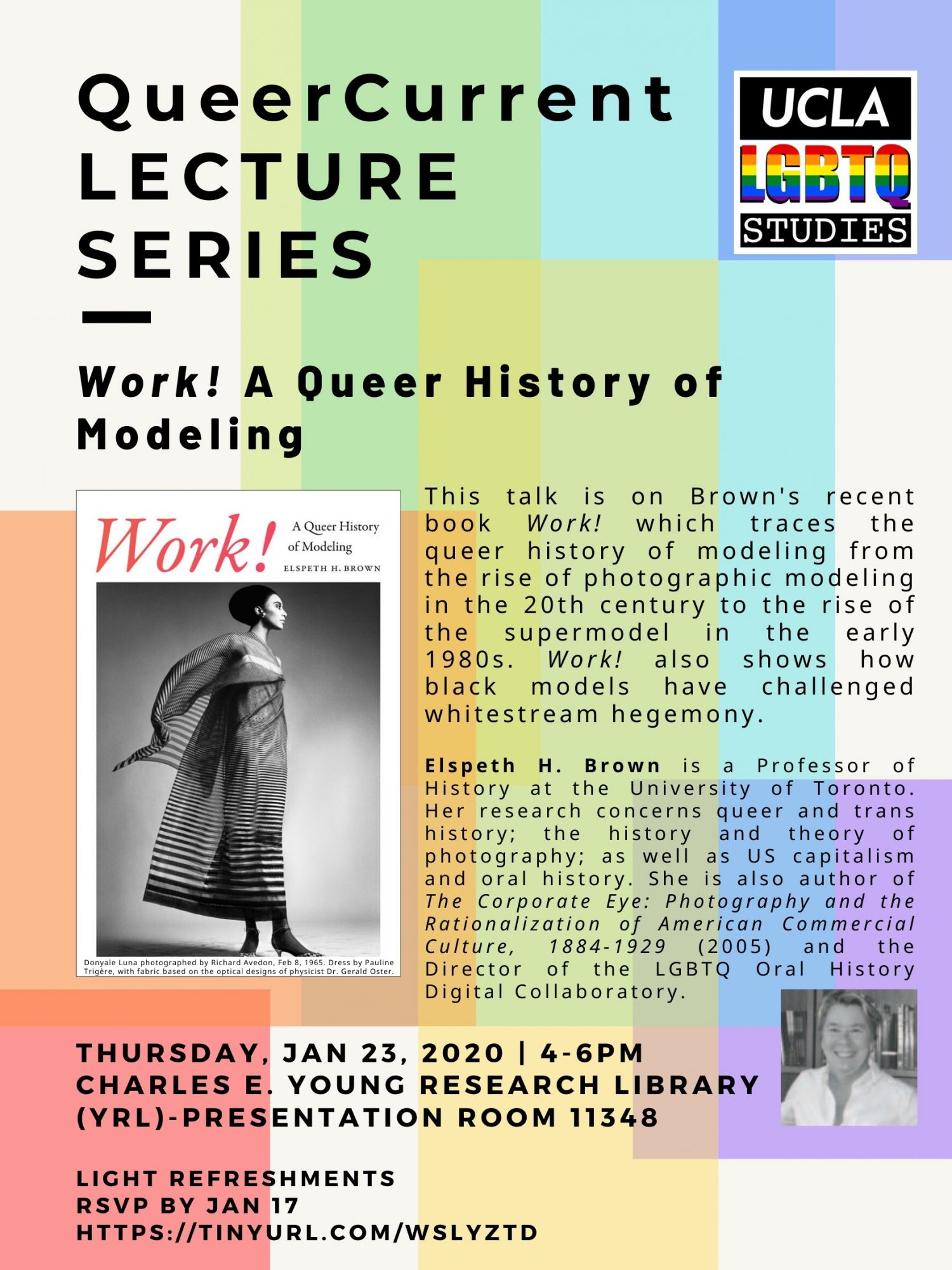Elspeth H. Brown, Professor of History at the University of Toronto, visited UCLA on Jan. 23 for the second event of the 2019-20 QueerCurrent Lecture Series. The talk was named “Work! A Queer History of Modeling,” after Brown’s most recent novel, which traces the history of modeling throughout the 20th century.
She calls her book a queer history not only because it discusses several LGBTQ+ folks, but also because it doesn’t follow a normative narrative of history. Instead, she adopts an intersectional approach, looking at modeling through lenses of queerness and whiteness.
“I thought I would be taking a much more rationalist argument about the work of modeling, seeing their work along the lines of standardized affect within industrialization,” Brown explained. “But as I got into doing more research, I found that approach didn’t fit what I was finding, and I kept discovering queer components of it.”
Meanwhile, the term “work” has two main references. On the one hand, it relates to the labor inherent in capitalism, which Brown explains is both racialized and gendered. On the other hand, it alludes to the performative strut or sashay featured in various queer communities.
Brown is especially interested in exploring modeling as a type of labor, which she calls affected labor, referring to the body’s ability to create states of emotion (sometimes called affect) in other people.
Both the lecture and the novel combine Brown’s knowledge of photography, capitalism, and LGBTQ+ history. In the words of professor Mitchell Morris, the chair of the LGBTQ Studies Program at UCLA, Brown was invited to the university for this lecture series because she is one of many people at the cutting edge of LGBTQ+ scholarship, publishing recent and relevant works.
Brown began her talk by highlighting Tracey Gayle Norman, the first famous Black trans model. She was featured on one of Clairol’s 1975 hair color boxes, as part of the “Born Beautiful” line. However, her career was cut short when her hairdresser’s assistant discovered that she was a trans woman and began spreading the word around the set. The company refused to continue working with her, and it wasn’t until 2016 that Clairol invited her back for their “Nice ‘n Easy Color As Real As You Are” campaign. (Brown pointed out how this campaign’s name resembles the title of Janet Mock’s autobiography, “Redefining Realness.” Both Mock and Norman are trans women of color who have gained prominence in the public eye in recent years.)
After her opening anecdote about Norman, Brown backtracked to the beginning of the 1900s, when modeling first emerged as a profession. Around this time, people began selling not the product itself, but the benefit the product promised, such as romance, sex appeal, or pleasure. As Brown described it, models sold things by making them desirable.
Although modeling can be seen as sensuous, Brown presented it as a managed, commercialized sexuality, comparable to the trope of the wholesome girl next door. In both cases, what is marketed as desirable is non-subversive and manufactured.
Before modeling became popular, most fashion magazines used pen and ink illustrations. It wasn’t until Baron Adolph de Meyer, known as the father of modern fashion photography, came along that well-known fashion magazines such as Vogue were convinced to shift toward photography in their prints. Techniques were used to liven up the photos, such as stretching lace across the lens to subtly distort the image. Lighting was especially important in highlighting the texture and folds of fabric and making the models seem extra attractive. Brown referred to de Meyer’s style as “a queer sensibility based on excess that has been central to fashion ever since.” (Both de Meyer and his wife Olga were gay!)
Around the same time as de Meyer’s revolutionary use of photography, Lady Lucy Duff-Gordon began displaying her clothing designs on living models rather than on sawdust dummies. With her help, viewing custom-made dresses turned into a flashy performance. Just as models today strut down runways to command attention, Duff-Gordon’s models used physical movement and dance to influence the emotions of potential consumers. Even the design’s names were excessive, such as one gown entitled, “The Sighing Sound of Lips Unsatisfied.”
Just as people who worked with typewriters became known as typewriters themselves, models took their name from the designs they sported.
After explaining how modeling as we think of it today rose to prominence, Brown jumped forward to the 1960s, when Black models made their first appearances. Although this meant the field of modeling became more diverse, it was founded on white designers who suddenly “discovered” Black models and began appropriating Black culture and selling it to white audiences.
Not all designers accepted Black models, and some refused to let them model their clothing. Even when Black folks did find modeling work, there were often racist, primitive undertones, such as having Black models wear animal-print fabrics, pose on all fours, and make paw hands. This fed into the stereotype that non-white bodies are closer to nature and played into harmful concepts of exoticism.
Brown finished her talk by highlighting the labor involved in modeling. Far from being passive mannequins, models exist to bring vitality and action to the clothes they showcase. By being familiar with the unique quality of various materials, they create an allure that incentivizes consumers to buy specific products, often drawing on their past modeling experience so they can decide how to best display each fabric.
Brown concluded by describing modeling as part of capitalist culture, “where the most important focus is building brands and selling goods.” Moreover, she added that, “Diversity on the runway doesn’t necessarily translate into equal rights and life chances for the minorities those models represent.” That, Brown emphasized, remains for the realm of politics to decide.

